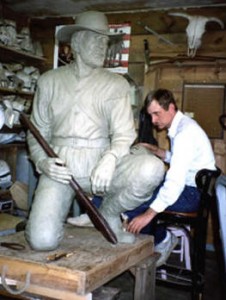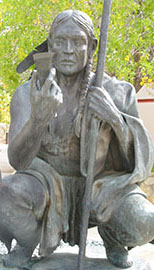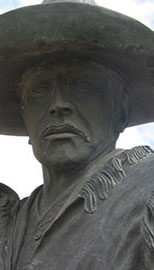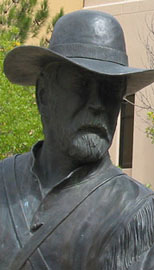The Traders Statue
“The Traders,” a Santa Fe bronze sculpture that is 1.2 life-size, was completed in 1988 and is permanently installed on the College of Business plaza between the Business Complex and Guthrie Hall. The Traders statue depicts early commerce during New Mexico’s territorial days. Set in circa 1850, the three figures represent the tri-cultural heritage of New Mexico: Indian, Hispanic and Anglo.
The statue’s dedication and unveiling were held on Homecoming Saturday, October 29, 1988, as part of NMSU’s Centennial anniversary and Homecoming celebrations.
Duke Sundt, Artist and NMSU Alumnus (’71) — I feel particularly fortunate to have been chosen to create this monumental sculpture entitled ‘The Traders.’ It was my intention to capture a moment in history, circa 1850, by portraying the positive and progressive interaction of these three people representing different cultures involved in the activity of trading goods. In researching this project, I met and visited with some very resourceful people who educated me on the history of early commerce in the state of New Mexico, as well as the type of clothing and tools used at that time. I am indebted to historian Charles Bennett at the Palace of the Governors, Santa Fe, New Mexico, and to Stephen Zimmer, curator for the Philmont Scout Ranch Museum, Cimarron, New Mexico, for their valuable assistance.
Of the eight monumental sculptures I have completed to date, ‘The Traders’ has given me the first opportunity to do a multi-figured sculpture with an historical theme. I enjoyed all aspects of creating it and hope all who see it will realize the effect and importance of trade among the Hispanic, Indian, and Anglo people in New Mexican history.
The Sculptor
Duke Sundt’s interest in sculpture can be traced back to his childhood memories of living in Copenhagen, Denmark, where monumental bronze sculpture is a common sight. He was fascinated with the huge works of art and made repeated visits to view certain favorite sculptures, an experience he never forgot.
In 1971, Duke received his Bachelor of Arts degree from New Mexico State University and upon graduating “began his education.”
I worked the bareback bronc riding event while rodeoing…. I then chose the next hardest way to make a living: being an artist.
As the artist, I chose an early trade scene circa 1850 in Northern New Mexico as my general subject. To insure the historical accuracy of my subject, I conducted extensive research at the Palace of the Governors Museum in Santa Fe, as well as the Ernest Thompson Seton Museum at the Philmont Scout Ranch in Cimarron, New Mexico.
—Duke Sundt, Riverbend Fine Art





